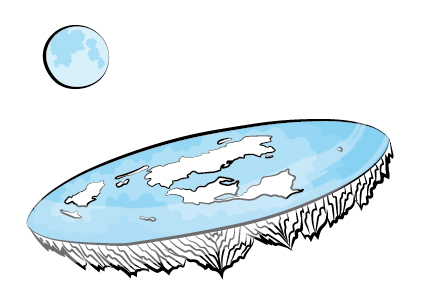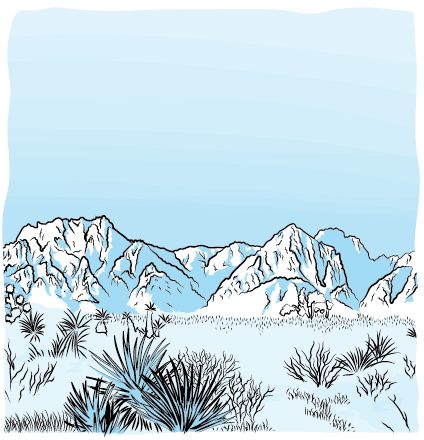
Mysteries of the New World
Twenty years before Jamestown was established, a small group of colonists settled Roanoke Island, off the coast of what is now North Carolina. When one of the colonists, John White, returned to the settlement three years later, the hundred people he had left were nowhere to be found, but their putative destination was carved into a post (not the tree that had been agreed upon): Croatoan. Croatoan was the name of a friendly tribe who lived on an island to the south. Were the settlers being held captive? Had they assimilated into Croatoan society? Nothing—not greater knowledge of the surrounding geography, not future visits to the site to unearth hidden treasures, not DNA tests on the modern residents of Roanoke Island—has answered the question conclusively.
The mystery lives on in online forums, where conspiracy theorists are quick to point out that this was not the only time the word Croatoan was connected to mysterious disappearances and deaths. Edgar Allan Poe is said to have repeated it, delusionally, in 1849, on his deathbed. Ambrose Bierce wrote it on a bedpost before disappearing in 1913. Amelia Earhart, who vanished in 1937, wrote it in her diary.
Coincidence, or something more? Perhaps it’s noteworthy that these online forums are the same communities where conspiracy theories are propagated around historical misapprehensions in cartography: the Mercator projection, the long-dominant and since-debunked world map that makes developed countries look bigger; the embarrassing number of eighteenth-century maps that render California as an island separated from North America by a narrow strait; all the way back to Henricus Martellus’s 1491 world map, which researchers believe Columbus used to sail the ocean blue in 1492, and which depicts South America before Europeans would have seen it—or so Paul Gallez alleged, in 1990, in The Tail of the Dragon. What information did Martellus have about South America’s existence?
Some lighter map-related fare aspires to similar insight. Consider America as Seen by Europeans, in which Texas occupies the entire space of the country between California and New York, or alternate-history takes like the map projecting what America’s borders would be had Native American nations expanded over the continent into the present day. In the meme titled “Sometimes I think North America is a fat dragon,” Canada becomes a dragon’s head and wings, Mexico its tail, Florida a claw, and the continental US its abdomen. In others, America is portrayed in the shape of a whale, a shark, a turtle.
We’ve gone, that is, from not knowing the shapes of whole continents in distant seas to knowing them so well that we take the liberty of forging alternate ones to suit the creatures of our imaginings. We can view America from space, see every line that parcels each state into personalities and ruling bodies, but online conspiracy theorists prefer to draw their conclusions from maps that are outdated, inaccurate, betraying some more or less sinister bias. Members of the Flat Earth Society, for example, believe the Earth is a disk surrounded by Antarctica, which isn’t a continent on the South Pole but an ice wall keeping the ocean from spilling into space. Instead of believing in those photos of the Earth from outer space, they argue that the moon landing was a conspiracy.
Besides their seriousness, the Flat Earthers and the meme-makers are not so different. Like Croatoan, the very first American mystery, the name of a friendly people turned into a metonym for the unknown and unsolved, it’s a vision of another new world: a sort of Atlantis that takes in every unsolved mystery, fully formed, and protects it from reality. Whether evidence-based, imagined, or crafted in the self-assured crucible of the internet, such mysteries unite us as inhabitants of the Americas—where, despite our individual leanings, liminal spaces wide enough to hold both fact and conspiracy theory bring us together.
Kayla Dean

Eradicating America
Something there is that doesn’t love America, that sends meteors and mother ships, sleeper cells and pathogens to wreck it. Our skylines are incinerated at the Sunday matinee; hundreds of millions of our fictive compatriots are murdered by cyborg, zombie, and virus; at least a couple dozen imaginary presidents are ousted from office by villains foreign, domestic, and extraterrestrial. Maybe we’re drawn to these fictions because the United States hasn’t actually weathered its own demise. Maybe the impetus for all this virtual self-destruction is guilt. A nation built on the genocide of indigenous nations, on enslavement and segregation, on an economic system that disdains the needy while exploiting their labor and resources across the world—the only nation on the two American continents that hoards the word America all for itself—might rightly believe a reckoning is coming. An optimist might claim, on the other hand, that there’s an element of good-sense self-preservation in our dour imaginings: maybe we’re busy rehearsing our own downfall so we can better prevent it. Either way, it’s an arrogant and juvenile imagination that conceives only an extraordinary end for itself. What we really ought to be contemplating is collective death by diabetes or by the slow broil of a brutalized climate. But we’re too busy depicting the drastic possibilities, playing “What If the Nazis Had Won the War?” or fretting about the machinations of the deep state, for that.
Still, how gutless every American suicide dream is. None of these snuff stories are ever final. There’s always a hardy band of resisters, hunger gamers, or reluctant soldiers, the chosen few with the gumption to survive and rebuild. This is the mythic resiliency of the American spirit extrapolated into a bleak future, but also evidence of a populace less interested in its own reckoning than obsessed with its self-regard. After all, there is no cleaner slate for the enterprising entrepreneur than the post-apocalypse. Even if we believe there’s something woefully wrong with the US, that the shining city on a hill is a sham and whatever ails us can be corrected only by another bloody revolution, those would-be survivors still bug me, the way they enact our incessant desire to resurrect America even after it’s failed itself. Strange, in that aftermath, to attempt another edition of this place and expect a different result. This is the kind of thinking that brings about Blackshirts and Third Reichs: We will be great again.
What nobody here ever seems to consider is that the best way to get America right might be to end it at the beginning, to eradicate it not just from the earth but from history and reality altogether. Enter Pierre Senges’s The Major Refutation, a brilliant rendition of a possible world in which the New World never existed at all except as a con job pulled on the rubes of sixteenth-century Spain by Columbus and his coconspirators. The Refutatio major purports to be an undiscovered text in which Spanish writer Antonio de Guevara delivers a screed against the existence of the western hemisphere a few decades after 1492. Senges poses as translator, bringing Guevara’s Latin into French (which Jacob Siefring has meticulously brought into English). Guevara really existed, and his widely accounted-for body of work is devoid of evidence that he ever disputed the fact of the New World, but Senges convincingly deploys Guevara’s voice throughout this counterfeit text, gleefully evoking actual events and lampooning major historical figures, from the charlatan Amerigo Vespucci and the complicit and duplicitous Queen Isabella I to every conniving sailor and explorer who followed. Rehearsing the masculine geek-ese of scholarly authority, Senges’s tome includes every trapping of formal academic prose, including an editor’s foreword, an epilogue, an afterword, and a coda, as he makes historicity his target.
But it’s the ease with which Senges convincingly delivers The Major Refutation as a real historical artifact that makes it both deft and instructive, even if the shtick’s embellishments can get taxing. If you’re wondering why we should wade into such indulgent trickery, then wonder also why there are ten movies and manifold secondary TV shows devoted to the Skywalker saga. The difference is that Senges strives to pass off his fiction as fact. All it seems to require is a little true-to-life voice peppered with credible allusions, and those of us without expertise in sixteenth-century Spanish literature are left googling Guevara and Charles I of Ghent, perhaps believing that disbelief in the New World was common among European intellectuals of the era. How, we might even wonder, do we know anything we know? Senges’s Guevara is as smug as he is certain, delivering a snarky, structured assault against the westerly continents founded on no shortage of “credible” surmise and “reasonable” assertion, every argument—credible or not—constructed almost entirely of the pathetic fervency of a single human voice stitching an amalgam of approximate facts into what we too respectfully refer to as rational thought. The experiment thus elucidates how the authority of pundits, tyrants, and idiots everywhere is exercised, all those mansplainers staking claims to undeniable truths that are little more than their own intuitions petrified in a posture of rationality. Flat Earthers, anti-vaxxers, climate-change deniers, and Republicans unite: The Major Refutation is a dissection of your curious dispositions.
Why a mind might seek to deceive itself in the first place is another question we find obliquely answered here. Senges’s conjuring of Guevara asks us to consider how existential a threat a “new world” might have been for a fifteenth-century European. Today the potential discovery of life elsewhere in the universe is often described as humanity’s most transformative could-be achievement, but the Spaniard of 1493 had already experienced a version of that mind-bender: life had been, impossibly, discovered on the other side of an endless ocean, and to a man like Guevara it might have represented half a planet utterly unknown to him, to his church and state, to the best minds of his generation and every generation prior. Imaginary Guevara’s raging defensiveness in The Major Refutation is understandable in such a context: as our own sci-fi asserts, new worlds tend to vaporize old ones. The fate of the peoples on the other side of that ocean was terrible, unjust, and undeserved, but for those back home on Planet España the encounter might have been shattering in a different way. Suddenly the world they knew was half what it had been, with themselves no longer quite at the center, and I suppose that, too, is an end of history.
To those like our pseudo-Guevara—convening even now at Fox News, Infowars, and elsewhere—any alternative, even a fallacious one, might be preferable to that reality. Thus Senges’s deceptive autopsy of self-deception confirms the denial of facts as a sad, defensive tactic of the too-delicate ego. The mind inclined to indulge in such absurdity is just so frightened by its insignificance that it turns to vast conspiracies to qualify its own importance. What could be a more American inclination than that?
Jaswinder Bolina

The humbling of hyperreality
A
nyone skimming Jean Baudrillard’s America today may be forgiven for suspecting that this Reagan-era travelogue-treatise is cut from the same cloth as the hoaxes of YouTubers who call CNN “fake news” but who believe Pizzagate was real. The author of The Gulf War Did Not Take Place drinks whiskey and marvels at the “Pompous Mormon symmetry” of Salt Lake City, laments the loss of a male/female dynamic in our culture (“The outer signs of masculinity are tending towards zero, but so are the signs of femininity”), wonders why women don’t wear ankle bracelets anymore, and calls joggers “the true Latter Day Saints and the protagonists of an easy-does-it Apocalypse.” He thinks the banks are up to something because they discourage him from carrying cash. He posits an evil-squirrel conspiracy theory that prefigures Rick and Morty by three decades. He does not have the prescience, in 1986, to call students “snowflakes,” but he does liken the university to an aquarium. “There is a science-fiction story in which a number of very rich people wake one morning in their luxury villas in the mountains to find that they are encircled by a transparent and insuperable obstacle, a wall of glass that has appeared in the night,” he writes. “Some of the university campuses here remind me of this.” Take away the casual allusions to Karl Marx and Paul Virilio and our narrator sounds an awful lot like Proud Boys founder Gavin McInnes.
For Baudrillard, though, it’s the American desert—“a sublime form that banishes all sociality, all sentimentality, all sexuality”—that checks our excesses of simulation and hyperreality as typified by motel chains, fast food, replaceable pop stars, and the logo-like ubiquity of the American flag. Our deserts act as a collective corrective to the dizziness of reproduction, the arrogance of our symbols. “The natural deserts tell me what I need to know about the deserts of the sign,” he writes. “They create a vision expurgated of all the rest: cities, relationships, events, media.” Baudrillard finds no hope for an America that he calls a hologram, but before these desolate sands he drops all critique, advising us mystically that we “should always appeal to the deserts against the excess of signification, of intention and pretension in culture. They are our mythic operator.” It’s a vision in line with Shelley’s in “Ozymandias” and Bowles’s in The Sheltering Sky, one in which deserts put all stabs at civilization, however simulated, in their place. No wonder their proximity to the most extreme examples of American artifice—Hollywood, Las Vegas, Disneyland—is central to his adoration. Neither Sin City nor the Happiest Place on Earth will be spared the judgment of silica and time.
Roberto Ontiveros

Primary sources
I have never read poetry for an international studies class, but it probably would have helped me
understand the politics. “Poetry is instrument; allows us to see through thought,” writes Marwa Helal in the zuihitsu “poem for the beings who arrived,” following a train of thought inspired by Neruda. Helal’s book Invasive species, an investigation of the author’s relationship with the United States and Egypt, cuts through the din of the constant news cycle, arriving at a momentary understanding of the barbarity of American foreign policy and global immigration systems. A poet with a master’s in creative nonfiction, a bachelor’s degree in international studies and journalism, and a passion for biology, Helal works the threads of her former aspirations, writing in one poem that “journalism is the work of the sleeping. poetry is the work of the dreaming.”
Helal weaves at a steady pace through dreams, anecdotes, conflicts, encyclopedia excerpts; even when she writes in prose, she is dreaming. The poems in Invasive species take place in writing workshops, college classrooms, and American naturalization ceremonies, on subway cars and Brooklyn rooftops, but their scenes are all situated firmly in Helal’s mind, where Aleksandr Solzhenitsyn, The Game, and June Jordan float around. The collection itself transcends genre; mixing memoir, political theory, and interrogation, Helal challenges the reader to question rules and borders, as she has been doing since college.
i have very distinct memories of being in undergrad international studies seminars and getting into arguments with my fellow africans who insisted that north africa is not part of africa. and why is that, hmm? isn’t it for the same reason they divide everything? what am I trying to show you?
According to the International Studies Association, the field is “dedicated to understanding international, transnational and global affairs” and comprises “academics, practitioners, policy experts, private sector workers and independent researchers, among others.” But what immigrant is not also versed in global affairs? Helal follows the legacy of genre-defying academics, and draws from intellectuals such as Baldwin, Borges, and Du Bois, guiding the reader through her life while presenting a new, syncretic kind of scholarly knowledge.
In “Immigration as a Second Language,” Helal recounts, in prose, the time in her twenties when she aged out of the immigration system and was forced to move back to Egypt:
I come back to the U.S. because it is what I know. Because this is where my family and friends are. Where my home is. Where my work is. I come back because I am American. It is hard because Egypt is where my family and friends are. Where my home is. Where my work is. It is hard because I am Egyptian.
The language here is simple, and less vigorous than the verse, but in its simplicity it cuts a hole in the nationalism holding up this country and many others: one that teaches us that an American cannot be loyal to another country, that if you’re American only America can be home.
International studies teaches us about nationalism and borders, about definitions of democracy, but what of the psychological effects of belonging to two countries at once? Helal is “tired of working so hard to prove my worth to a country that has yet to see me, and us. Tired of fighting myself on how to tell this story without betraying myself.”
Invasive species shows the American immigration system through a personal journey and a cultural moment, a perspective often lacking from our narratives of twenty-first-century global migration. Helal exposes our illusions, and her own, about what makes us American, how this country does and does not reward “good” immigrants. She lists her achievements and identities over the course of her lifetime in the US before she had to leave:
I was a National Honors Society student; captain of my Midwestern division three state qualifying tennis team… a volunteer taking vitals at the local hospital’s emergency room, holding babies down for stitches; your friendly college dorm room RA; leaf raking, waving-hello-suburban-next-door neighbor.
All of these things do not an American make, just as the study of movement between nations is not necessarily international studies. When you study international studies and journalism but also pursue a career as a poet, the text you produce might be poetry, but it might be international studies, or American studies, or Middle Eastern studies, or African studies, or comparative literature. It might be biology. Invasive species is a critique of Americanness, whiteness, and the homeland security state, and also a love letter to Helal’s country—“both of them”—and her mentors, living and dead (“depending on whether you believe a writer lives in her writing”). It is a work of anger, frustration, grief, exhaustion, and loneliness, but also one of hope. It is a work of scholarship, undeniably, except it comes from a future where scholarship has been decolonized and the International Studies Association comprises academics, poets, domestic workers, researchers, taxi drivers, and community organizers. Or perhaps there will be no International Studies Association, because there will be no ivory towers to contain it.
Sophia Steinert-Evoy

A landmass of the mind
Cowboys travel a landscape that no longer exists, but for a few brief years was real. The actual job, according to Sam Davis of the podcast Inward Empire, appeared in America right after the Civil War: the Union had cut off access to eastern markets, and millions of cows acted like cows, eating and fucking all across the southern plains. Men who wanted money herded up the cows and drove them en masse to sell at railroad hubs. These “cowboys” were mostly former Confederate soldiers or former slaves—almost exclusively male, hat wearing, gun carrying, and, to paraphrase celebrity cowman Charles Goodnight, edgy as all hell. They barely slept. They wore their boots for weeks on end. They ate a diet heavy in beef and lived a life without borders. “Don’t fence me in,” goes one cowboy tune. “Let me ride through the wide open country that I love.” For a few years, so it was. The plains and prairies seemed to be theirs alone, and with the land came just what they wanted: freedom.
But the historical cowboy, argues Agnes Morley Cleaveland, died when the first barbed-wire fence was erected. Born in territorial New Mexico, Cleaveland wrote in her best seller No Life for a Lady about growing up beside cowmen, watching them change from men whose labor was integral to the frontier economy—in essence, a mobile containment unit for livestock across huge swaths of land—to an early iteration of what they’ve become today: a monstrous symbolic conflation of outlaw and gunslinger, horse rider and do-good daddy. Outmoded though he is, this figure endures in the culture—say frontier three times fast and a cowboy will appear—evoking the landscape of a particular time and place, roping along anyone who yearns for a big open space belonging to him and him alone.
One of the more famous architects of the cowboy myth is Buffalo Bill, a self-proclaimed “Indian fighter,” who, a month after the Battle of the Little Bighorn, cut the scalp off a Cheyenne subchief named Hay-o-wei and promptly wrote to his wife about his plan to send the scalp to a neighbor’s store, complete with instructions for the window display. The mutilation was soon made melodrama on Broadway: first the Buffalo Bill Combination performed Red Right Hand: Or, Buffalo Bill’s First Scalp for Custer; the incident was then reenacted as a set-piece battle in Bill’s Wild West Show, which ran from about 1883 to 1920—a vaudeville with a “cowboy band” orchestra and a twenty-five-man ensemble that shot guns and did tricks. The cast of four hundred toured America and Europe. The pope saw the show; Queen Victoria asked for a private audience. The show helped divorce the West from its actual geography, transforming the place into an idea where tropes were born and bred: cowboys fought natives and rescued helpless women. They roped horses and defended mail coaches. Cowboys, or the actors who played them, propagated a reductive binary of good versus evil, all in fealty to a man who was so proud to have cut the scalp off another human being that he chose to reenact the deed onstage nightly for almost forty years.
Literarily speaking, the cowboy myth is particular to the psyche of one man: Owen Wister. Wister came from old money in Philadelphia, went to Harvard, and studied music composition for two years in Paris. “I have never camped out or gone shooting, but lots of boys have,” he wrote in a letter to his mother, one of nearly two thousand over thirty-eight years. “I don’t want to be a house boy.” Wister suffered nervous breaks when he returned to America to work as a lawyer; doctors diagnosed him as neurasthenic and recommended he get out of the city and visit Wyoming, then a kind of spa for Easterners. Writing down what he saw there, and what he saw disappearing, revitalized him—the frontier, the cowboys and their stories. In an 1895 essay for Harper’s Magazine called “The Evolution of the Cow-Puncher,” he wrote of men who slept in the dust and woke in the snow, who wore leathern armor and sat in stout saddles. The cowboy, he said, was a pure-blooded Saxon who didn’t care about money, because if money were at stake “our Hebrew friends would pioneer the whole of us.” (Frederic Remington, who illustrated the piece, was even plainer: “You can’t glorify a Jew,” he wrote in a letter. “I’ve got some winchesters, and when the massacre-ing begins, I can get my share of ’em, and what’s more, I will.”) Wister’s proto-Aryan cowboy was no Jew, certainly no immigrant; he seemed, incorrectly, to believe the frontier was clean of both. His 1902 novel, The Virginian, gave the figure form: a tall man with a mustache, drawling wisdom in a folksy patois, anything but a houseboy.
Together with Bill’s blood-hungry actors, Wister’s Virginian became the basis for the protagonists of thousands of novels and movies, a mythological conflation who brought the frontier with him wherever he went. The cowboy is a paradox, a brute omnipresent stand-in for American colonialism and the dehumanization of others who once had half a continent to themselves. When Thomas Jefferson said it would take a thousand years to settle the West, he was wrong in a literal sense, but may have been metaphorically right: as long as the cowboy sticks around, so does the American West in all of its easily malleable mythology. When Kennedy spoke, at his inauguration, of the 1960s as a new frontier, the cowboy was there in spirit; when the ambassador to South Vietnam justified a US invasion by saying, “It is very hard to plant corn outside the stockade when the Indians are still around,” there was the cowboy again. When a former western star was elected president: cowboy. The cowboy is the principal actor in the untamed landmass that is the West, a potent and renewable symbol in the American imaginary.
Gene Autry’s popular tune ends like this: “I want to ride to the ridge where the West commences, / gaze at the moon till I lose my senses. / Can’t look at hobbles and I don’t like fences. / Don’t fence me in.” Where cowboys live today is a place outside reality and the senses, inside the mind. In the mind, there’s no trouble. The moon is pretty. The horse is your friend. At night a fire burns to keep you warm, and thank god for that: the world outside can be a cold, lonely place.




